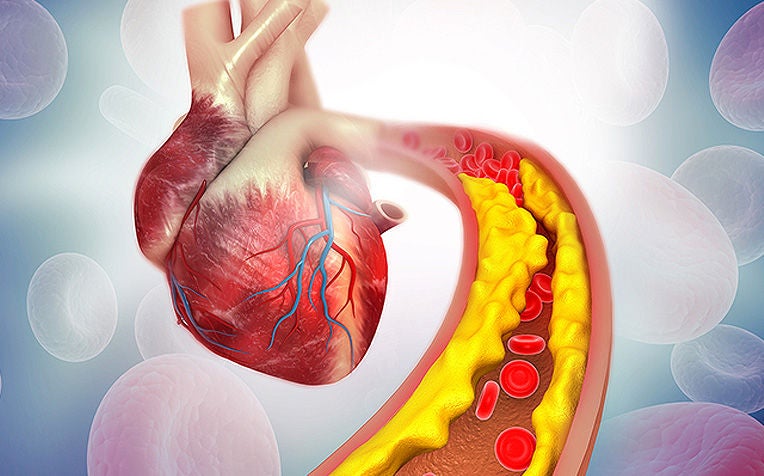
Atherosclerosis is the silent, stealthy hardening of arteries. Over time, it can cause a heart attack.
Atherosclerosis: Build-up of plaque in the arteries
Coronary atherosclerosis is a disease where the inside of the arteries are blocked by plaque. When the plaque breaks away, it can form blood clots that cause heart attacks.
Clinical Associate Professor Aaron Wong, Deputy Chief Executive Officer and Senior Consultant,
Department of Cardiology,
National Heart Centre Singapore (NHCS), a member of the
SingHealth group, shares, "There are many unknown factors which increase the risk of a heart attack. What we do not know, we cannot prevent or treat. But what we do know is that maintaining a healthy and active lifestyle is key for prevention.”
Treatment options for atherosclerosis (plaque buildup)
Once coronary atherosclerosis is diagnosed, there are three main forms of treatment:
1. Medication
Medicine, such as aspirin or statins, can be prescribed to reduce the risk of a heart attack and to treat the risk factors the patient has.
2. Stent surgery
A stent – a metal mesh tube – can be inserted into the blocked artery to keep it open so that blood can flow through. This method is typically used in patients with less severe or complex blockages.
3. Heart bypass
The patient can undergo a heart bypass, in which a vein or artery is taken from another part of the body and used to create a bridge around the blockage. Heart bypasses are done in severe conditions when all three arteries to the heart are blocked, and will usually last for about 10 years or more.
Those with high cholesterol levels, high blood pressure (hypertension) and
diabetes are advised to keep these conditions in check through proper medication, as they are risk factors for heart disease.
In addition, Prof Wong advises patients who have been treated for heart disease to be particularly vigilant with their lifestyle habits and to continue with their medication, even if their symptoms go away.
Atherosclerosis (plaque buildup): How does it happen?
Atherosclerosis – commonly known as the hardening of the arteries – is still something of a mystery. Exact causes are unknown but doctors say that unhealthy habits, such as heavy smoking and a fatty diet, greatly increase a person’s risk of developing it.
“When plaque builds up in an artery, it narrows the artery and reduces blood flow,” explains Prof Wong. Plaque builds up when cholesterol, white blood cells, calcium and other substances accumulate on an artery wall.
In time, the plaque can break off, causing a blood clot. If the clot is large enough, it can block blood flow through a coronary artery and cause a heart attack.
Prof Wong said that the narrowing of the arteries can affect the body in a spectrum of ways. For a start, the narrowing can be so gradual that the body’s natural compensation mechanism causes small capillaries to form, bridging the blockage before the artery is completely blocked.
This “natural bypass” prevents patients from having a
heart attack (myocardial infarction) even though an artery may be 100 per cent blocked. However, the patient may have
angina – the feeling of pain or tightness in his chest during physical exertion – with the pain typically going away when he stops to rest.
When the plaque build-up in the artery suddenly ruptures, platelets in the blood will rapidly cover up the rupture, leading to a clot forming, which narrows the artery further. If blood flow is completely blocked, the affected muscle loses its oxygen supply and a heart attack occurs.
If the blockage is not opened within 12 hours, the muscle supplied by that artery will be irreversibly damaged. Depending on its severity, a heart attack could lead to death.
Patients with atherosclerosis may show no symptoms for decades, until a sudden heart attack occurs.
Atherosclerosis (plaque buildup): Who is at risk?
Atherosclerosis (plaque buildup) typically affects those with poor lifestyle habits and medical conditions, such as high cholesterol, high blood pressure (hypertension) or diabetes.
Having a family history of heart disease also puts you at a higher risk of developing atherosclerosis, which usually affects men over 50 and women over 60.
“Smokers, people with diabetes and unhealthy eating habits run the highest risk of developing it (atherosclerosis),” says Prof Wong.
Is there a cure for atherosclerosis (plaque buildup)?
There is no cure for atherosclerosis, but there is hope. A patient who takes appropriate medical guidance and is willing to modify his lifestyle can live a relatively normal life.
“Coronary atherosclerosis is a degenerative disease which progresses with age even with a healthy lifestyle. But its progression is slower than in those who don’t look after themselves. If someone changes his lifestyle, it will definitely reduce his risk of a heart attack, compared to someone else who continues to live unhealthily,” said Dr Wong.
Ref: I23 (ed)
Check out other articles on heart health:
Sudden Chest Pains You Shouldn't Ignore
Heart Palpitations: When Are They Serious?
















 Get it on Google Play
Get it on Google Play